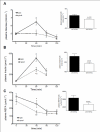Extremely short duration high intensity interval training substantially improves insulin action in young healthy males
- PMID: 19175906
- PMCID: PMC2640399
- DOI: 10.1186/1472-6823-9-3
Extremely short duration high intensity interval training substantially improves insulin action in young healthy males
Abstract
Background: Traditional high volume aerobic exercise training reduces cardiovascular and metabolic disease risk but involves a substantial time commitment. Extremely low volume high-intensity interval training (HIT) has recently been demonstrated to produce improvements to aerobic function, but it is unknown whether HIT has the capacity to improve insulin action and hence glycemic control.
Methods: Sixteen young men (age: 21 +/- 2 y; BMI: 23.7 +/- 3.1 kg x m-2; VO2peak: 48 +/- 9 ml x kg-1 x min-1) performed 2 weeks of supervised HIT comprising of a total of 15 min of exercise (6 sessions; 4-6 x 30-s cycle sprints per session). Aerobic performance (250-kJ self-paced cycling time trial), and glucose, insulin and NEFA responses to a 75-g oral glucose load (oral glucose tolerance test; OGTT) were determined before and after training.
Results: Following 2 weeks of HIT, the area under the plasma glucose, insulin and NEFA concentration-time curves were all reduced (12%, 37%, 26% respectively, all P < 0.001). Fasting plasma insulin and glucose concentrations remained unchanged, but there was a tendency for reduced fasting plasma NEFA concentrations post-training (pre: 350 +/- 36 v post: 290 +/- 39 micromol x l-1, P = 0.058). Insulin sensitivity, as measured by the Cederholm index, was improved by 23% (P < 0.01), while aerobic cycling performance improved by approximately 6% (P < 0.01).
Conclusion: The efficacy of a high intensity exercise protocol, involving only ~250 kcal of work each week, to substantially improve insulin action in young sedentary subjects is remarkable. This novel time-efficient training paradigm can be used as a strategy to reduce metabolic risk factors in young and middle aged sedentary populations who otherwise would not adhere to time consuming traditional aerobic exercise regimes.
Figures
References
-
- Hickey MS, Weidner MD, Gavigan KE, Zheng D, Tyndall GL, Houmard JA. The insulin action-fiber type relationship in humans is muscle group specific. Am J Physiol. 1995;269:E150–154. - PubMed
LinkOut - more resources
Full Text Sources
Other Literature Sources
Miscellaneous


